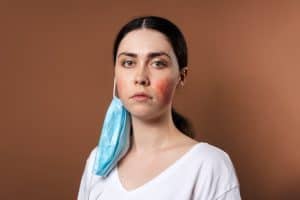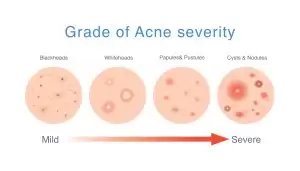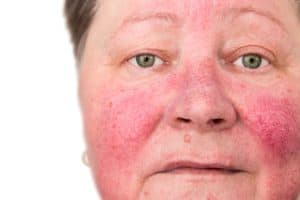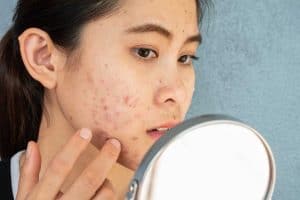Acne and rosacea are among the most common skin conditions, and they can affect anyone. Both show upon the skin as redness and inflammation, and treating them is relatively easy — but only if you can tell them apart.
Learn about the difference between acne and rosacea, as well as how to treat either so you can say “goodbye” to redness, and “hello” to clear skin.

What is Acne?
Acne (also known as acne vulgaris) is a skin condition caused by multiple factors, including excess oil on the skin, dead skin cells, bacteria, and inflammation.
When your skin’s oil glands (sebaceous glands) produce too much oil (sebum), it can build up in your pores or hair follicles. When this mixes with dead skin cells and/or bacteria in your skin’s pores, it can lead to the inflammation and irritation that causes acne a.k.a. pimples.
Acne tends to appear on the face, neck, back (also called bacne), chest, and shoulders. During hormonal changes, like puberty, menstruation, or pregnancy, your skin might produce too much oil. It’s common to experience acne during such times.
Types of Acne
The common types of acne are the bumps or lumps that appear on your skin. Acne can appear as any of the following:
Whiteheads and blackheads are closest to the skin’s surface.Whiteheads are white or yellowish bumps covered by oil and dead skin cells. Blackheads form when excess oil and dead skin cells clog pores, commonly on or around the nose. The clog turns black dark as it’s exposed to air.
Papules and pustules tend to be bigger, more painful pimples caused by infection and inflammation of the pore. Papules are solid raised bumps with no heads. Pustules are filled with pus and look like large whiteheads surrounded by an inflammatory red ring.
Cysts and nodules form deep in the skin and can be large and painful. These often cause scars when not treated appropriately. The difference between cysts and nodules is that nodules will feel solid, while cysts will not because they are filled with pus.
Struggling with Acne?
Does this sound like you? Pandia Health now offers online acne treatment, bringing the doctor's office to you with telehealth services so you can receive prescription acne treatment (and birth control!) without leaving home.
Sign up for Pandia Health and our expert birth control doctors will find the best acne treatment for you.
What is Rosacea?
Like acne, rosacea is a common skin disorder. Rosacea usually only appears on the face. However rosacea can also happen on the neck and chest, causing redness in the affected areas. Over time, and if left untreated, the redness may become more intense.Rosacea is usually redness, acne, and small, visible blood vessels.
Rosacea is a long-lasting condition and can cycle between flare-ups and periods of remission. A few common symptoms of rosacea include:
- Facial redness: This is characterized by blushing or flushing that lasts for long periods, and it may also be accompanied by a tingling or burning sensation. Reddened skin may turn dry, rough, and scaly.
- Rash: Where there’s facial redness, you may start to develop red or pus-filled bumps. If this is the case, telling the difference between acne and rosacea becomes difficult for non-doctors.
- Visible blood vessels: These will appear as thin, red squiggly lines on your face.
- Skin thickening: In the reddened areas, particularly on the nose, your skin may thicken and look enlarged and bulbous.
- Eye irritation: Your eyes may become red, itchy, watery, dry, or sore. If eye irritation is left untreated, eye damage or vision loss can occur.
Acne vs. Rosacea: Is Rosacea a Type of Acne?
No, rosacea is not a type of acne. While rosacea and adult acne may look similar in some cases, they are two different skin conditions. Rosacea is not a form of acne vulgaris, though it can trigger pimples to flare up at times. Also a key difference is that Rosacea happens in 30-50 year olds. Acne usually starts in the teenage years.
What Causes Rosacea?
The exact cause of rosacea is unknown. However, there are several similarities between those who experience it and the circumstances that trigger it.
People who experience frequent flushing, redness, bumps and pimples, have fair skin or have visible blood vessels are generally more likely to experience rosacea. Rosacea appears more commonly in adult women and those assigned female at birth, but men or those assigned male at birth might have more severe symptoms.
Unlike acne, rosacea is not brought on by clogged pores, it’s generally caused by genetics or a reaction to certain lifestyle factors. These triggers can include sun exposure, heat, alcohol, spicy foods, and caffeine.
Types of Rosacea
Rosacea is distinguished from acne by age of the person, redness (visible blood vessels), and being on the face, but it can take a few different forms with varying levels of severity. Let’s go over what rosacea can often look like so that you can know how to address your condition.
Erythematotelangiectatic Rosacea
This hard-to-pronounce type of rosacea hascomprises persistent facial redness that’s there all the time. Small blood vessels beneath the skin become enlarged and visible. Without treatment, this type of redness can last for longer and longer times, covering more skin, and may even become permanent.
Papulopustular Rosacea
Papulopustular rosacea is where the confusion of acne vs. rosacea comes from. This type of rosacea is characterized by “whitehead” pustules, which are pus-filled blemishes, and red, swollen bumps. These can flare up on the cheeks, chin, and forehead (much like acne), resulting in facial redness.
Rhinophyma
Rhinophymatous rosacea causes the skin to thicken and scar, making it bumpy and swollen. This type of rosacea appears most often on the nose, resulting in a bulbous nose (or rhinophyma).
Ocular rosacea
Ocular rosacea is the presence of rosacea around the eyes, which causes them to look watery or bloodshot. You may experience burning or irritation if you have ocular rosacea. It can also cause persistently dry and/or sensitive eyes.
Acne vs. Rosacea: What’s the Difference?
When comparing acne and rosacea, take a moment to look at the affected area of your skin. With acne, facial redness only appears around the pimple, while rosacea will typically cause redness like a blanket over the nose and cheeks that can last a long time and be painful.
What kind of redness are you experiencing?
Other differences between acne and rosacea include the causes and triggers of the conditions. Acne is often caused by hormonal changes and excess oil production, while rosacea is thought to be caused by a combination of genetic and environmental factors, such as sun exposure, alcohol consumption, and spicy foods.
Additionally, while acne is treated with a variety of topical and oral medications, rosacea is usually managed with lifestyle changes (avoid the things that bring on the rosacea), topical prescription only therapies that are very different from what is used for acne (such as metronidazole gel or brimonidine), and in some cases, oral medications.
Get the Best Acne Treatment
If you’re struggling with acne, sign up for Pandia Health and our board-certified expert doctors will find the best treatment for you from the comfort of your home or wherever you have internet. Skip the trip to the doctor’s office and also the pharmacy thanks to our FREE delivery service! Get started with Pandia Health today!
Pandia Health is dedicated to providing accurate and reliable health knowledge. Check us out on Instagram, TikTok, YouTube, and our blog for more information about acne treatments, women’s health, and lifestyle habits.
Disclaimer: The above information is for informational purposes only and is NOT a substitute for professional medical advice. Always seek the advice of your doctor or healthcare provider before starting or changing treatment.




